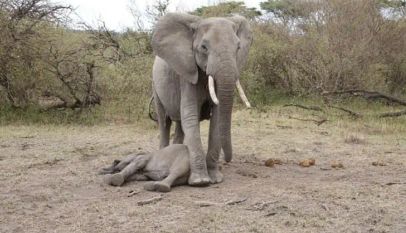
In the heart of Namibia, across the vast plains of Etosha National Park, a truly mesmerizing spectacle awaits anyone who ventures into its sunbaked landscapes. Here, among the salt pans and sparse vegetation, roam creatures that seem almost otherworldly — the so-called “ghost elephants.” Unlike the familiar gray elephants seen in other parts of Africa, these giants are covered in a pale, chalky layer that gives them a ghostlike, ethereal appearance. They appear as if they have stepped out of a dream, their massive silhouettes drifting silently across the arid savanna, blending seamlessly with the shimmering horizon.
The unusual appearance of these elephants is no trick of light or imagination; it is the product of one of nature’s most extraordinary survival adaptations. In Etosha, the sun can be merciless, with daytime temperatures soaring past 40°C (104°F). The landscape offers little shade, and the heat is relentless, making survival a constant challenge. For elephants, whose large bodies retain significant heat, simply resting in the open is not an option. They require a method to cool themselves, protect their sensitive skin, and guard against insect bites.

The solution is ingenious: mud bathing. When the elephants find a patch of wet soil or waterlogged earth, they submerge themselves, coating their massive bodies in mud. As the water in the mud evaporates, it draws heat away from their skin, lowering their body temperature. But the effect goes beyond simple cooling. The soil in Etosha is rich in minerals, particularly white clay and lime, which are left behind as the mud dries. Over time, this natural layer forms a protective crust, shielding the elephants’ skin from harmful UV rays and helping to retain moisture.
The result is the striking white appearance that has earned these elephants the nickname “ghosts.” Walking through the desert, they seem to float across the landscape, pale and spectral, moving with the silent dignity of beings that belong to a world slightly removed from our own. It’s a phenomenon that has fascinated visitors, photographers, and wildlife enthusiasts, all drawn to the haunting beauty of these mineral-coated giants.
The ghostly layer also serves practical purposes beyond heat management. It acts as a natural barrier against parasites and biting insects, which can otherwise cause irritation or transmit disease. It also reduces the risk of sunburn, a danger for elephants whose skin is thick but sensitive to prolonged exposure in extreme heat. The combination of behavior and environment results in an adaptation that is both elegant and efficient — a perfect example of how animals adjust to extreme conditions through a mix of instinct, environment, and survival needs.
Watching the ghost elephants in motion is mesmerizing. They move slowly, deliberately, across the plains, their steps silent on the dry earth. The white crust of clay and lime makes their skin appear almost unreal in the shifting light of sunrise and sunset, blending with the pale tones of the landscape. From a distance, they seem like phantoms, walking between worlds — a living reminder of the delicate balance between life and environment in the African wilderness.
While humans do not possess the natural adaptations of Etosha elephants, we have developed our own methods for coping with heat through ingenuity and technology. Where elephants rely on mud, mineral layers, and instinctive behavior, humans have invented clothing, shelter, and cooling devices. From lightweight fabrics that reflect sunlight to air conditioning that replicates natural cooling, human survival in extreme heat depends on creativity rather than biology. Even innovations like SunStop® apparel from TokyoLife mimic the protective and cooling functions that elephants achieve naturally, offering sun protection and comfort without needing to cover oneself in mud.
The story of the ghost elephants serves as a reminder of the profound ways animals adapt to their environment. Their white, mineral-coated skin is not only a visual marvel but a lesson in resilience and survival. By observing them, humans can appreciate the ingenuity of nature and the ways in which life finds solutions to seemingly insurmountable challenges. It also underscores the importance of protecting habitats like Etosha, where these incredible adaptations can continue to thrive.

In addition to their survival strategies, the ghost elephants are an essential part of the ecological fabric of the park. They help maintain balance in the ecosystem, dispersing seeds, creating waterholes used by other species, and contributing to the health of the savanna. Their survival strategies, like the mud-bathing behavior that leaves them ghostly white, also affect how they interact with other animals, avoiding overheating while foraging and engaging socially within their herds.
Photographers and wildlife researchers often describe the experience of seeing ghost elephants as almost surreal. The sun glints off the pale clay and lime covering their bodies, their massive ears flaring as they move, creating a spectacle of light and shadow. It is a visual metaphor for the adaptability of life, a living testament to how animals can endure and even thrive in some of the harshest environments on the planet.
For visitors to Etosha National Park, the ghost elephants are more than just a photographic curiosity. They are a symbol of endurance, adaptation, and the extraordinary creativity of nature itself. Watching them navigate the heat, mud, and sun-soaked plains inspires awe and humility. They remind us that survival in extreme conditions is a blend of instinct, environment, and learned behavior, resulting in beauty, function, and resilience.
From a pale, ghostlike coating that protects their skin to the practical benefits of cooling and insect deterrence, these elephants illustrate the intricate solutions that nature provides to the challenges of life. In a world increasingly defined by environmental stress and climate extremes, observing the ghost elephants teaches us lessons about adaptation, resilience, and the intersection of necessity and ingenuity.
In the end, the ghost elephants of Etosha are more than a visual wonder. They are living examples of nature’s brilliance, a reminder that survival and beauty can coexist, and that the lessons learned from the wild can inspire human innovation, creativity, and respect for the natural world.






